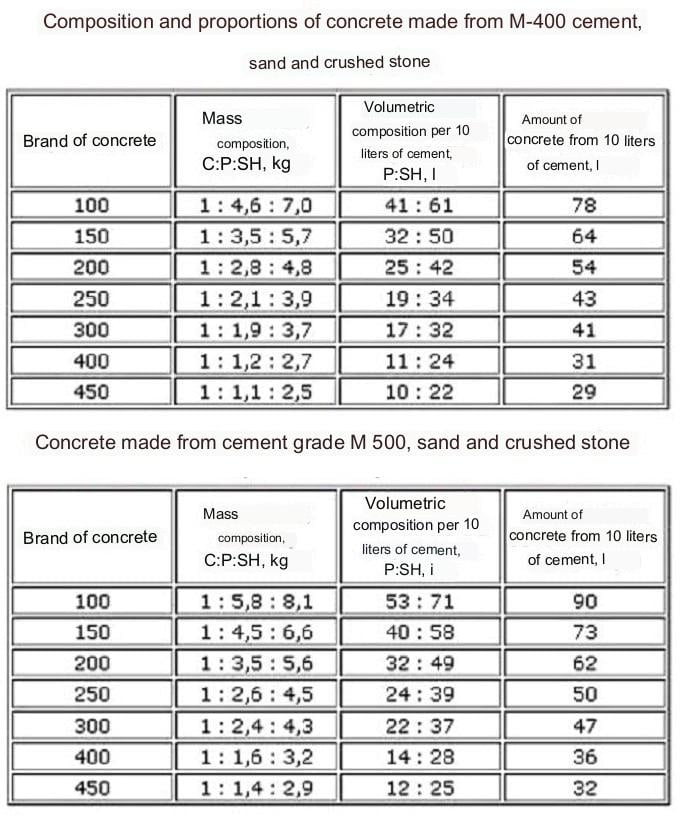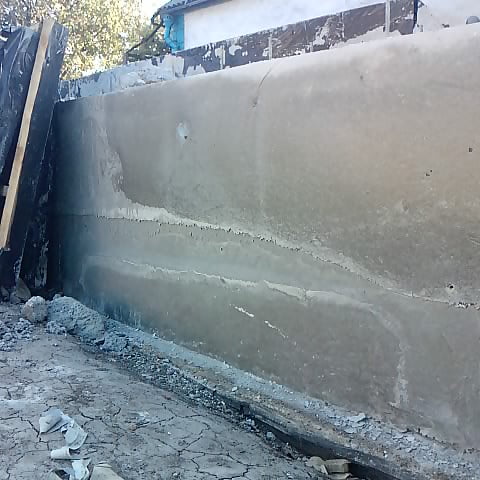In this article, we will discuss what concrete is, its composition, concrete grades, component ratios, and how to make concrete for different types of foundations.
Composition of Concrete for Foundations
We assume that most of you already know what concrete is. Just to remind you, it is a mixture used in construction to create sturdy stone structures. It is employed for building foundations, floorings, supports, columns, dams, roads, and pathways around buildings. In short, the applications of concrete are vast. However, we will specifically focus on concrete for foundations.
To build the foundations of buildings, utility structures, fences, and so on, concrete is used, which consists of:
- Cement – the primary component of foundation concrete. It is the main binding agent in concrete.
- Sand – the foundation concrete should contain clean, medium-sized quarry or river sand. No impurities like clay are allowed in it.
- Gravel – for the foundation, granite or gravel aggregate with a particle size of 5-20 mm is required.
- Water – it should be clean.
- Plasticizer – various plasticizers for concrete are widely used nowadays. If you want to make high-quality concrete for the foundation, be sure to use a suitable plasticizer for your needs. It significantly facilitates mixing and applying concrete, and cleaning tools, extends the working time with concrete, and adds strength and flexibility. There are also special additives for working in cold weather, adding waterproofing properties, and more to the foundation concrete.
The composition and proportions of foundation concrete determine its grade. What is it? Read on.
Concrete Grade for the Foundation
Let’s clarify that for constructing the foundation, concrete grades from M100 to M350 are suitable. Now let’s see what this depends on and what it means.
It’s pretty simple: the letter M denotes the concrete grade and indicates the strength limit in numbers. That is, how many kilograms per square centimeter can withstand the concrete of this grade? Grade M200, the most common for building foundations of private houses, means that the concrete can withstand a load of 200 kg per cm2.
In addition to the concrete grade, the concept of a concrete class is often used. It is denoted by the letter “C.” For the foundation, concrete classes from C7.5 to C25 are suitable. Below, you can see a table showing the correspondence between the class and the grade of concrete.

So, what grade or class of concrete is suitable for a specific type of foundation?
What Concrete is Needed for a Foundation
Depending on the type of construction you want to build a foundation for, you need to choose the right grade of concrete. The more responsible and heavy the structure, the stronger the foundation concrete should be, and the higher the grade or class of concrete should be.
For the construction of foundations for light utility structures such as gazebos, greenhouses, and chicken coops, concrete grades from M100 to M150 are suitable.
For a sauna, garage, and similar structures, you can use concrete grades from M150 to M200.
For the foundation of a private house, use concrete with a grade of M200 or higher.
All the provided figures are quite conditional. If you don’t have a project for the structure you’re building and you’re unsure about the strength of the future foundation, choose concrete with a higher class. Also, keep in mind that self-prepared foundation concrete may have a lower grade compared to factory-made concrete.
Proportions of Foundation Concrete
So, you’ve decided on the grade of concrete for your foundation. It’s time to find out what proportions of foundation concrete you need to follow for this.
It’s no secret that most “home builders” use standard formulas with component proportions to prepare foundation concrete.
In general, there are two common types:
- For “regular” concrete – 1 part cement, 3 parts sand, 5 parts gravel. Add water sparingly but enough to reach a plastic consistency.
- For “strong” concrete – 1 part cement, 2 parts sand, 4 parts gravel.
In principle, such formulas have their place, as they are suitable for most foundations in private construction. However, if you want to build your foundation correctly, use a table that provides the proportions of concrete for the foundation.

The table provides not only the concrete proportions for the foundation in kilograms but also in parts. This is because many builders use measures like buckets or shovels to measure the necessary proportions. If you find it more convenient to use this method for dosing the components, for example, in buckets or shovels, you will find the concrete proportions for the foundation in buckets on the table. This is because “parts” can be replaced by any volume measure, whether it’s buckets, shovels, scoops, or even by hand.
Remember that the concrete proportions for the foundation in kilograms and buckets are not the same. This is because cement, sand, gravel, and water have different specific weights. A 10-liter bucket will weigh 10 kg with water, about 12 kg with cement, 14 kg with sand, and 15 kg with gravel. However, these figures are approximate because cement can vary from loose to compacted, sand can be wet, and gravel can be coarse or fine.
And finally, watch the video that explains how to make concrete and provides all the proportions for the foundation. Good luck with your construction!
